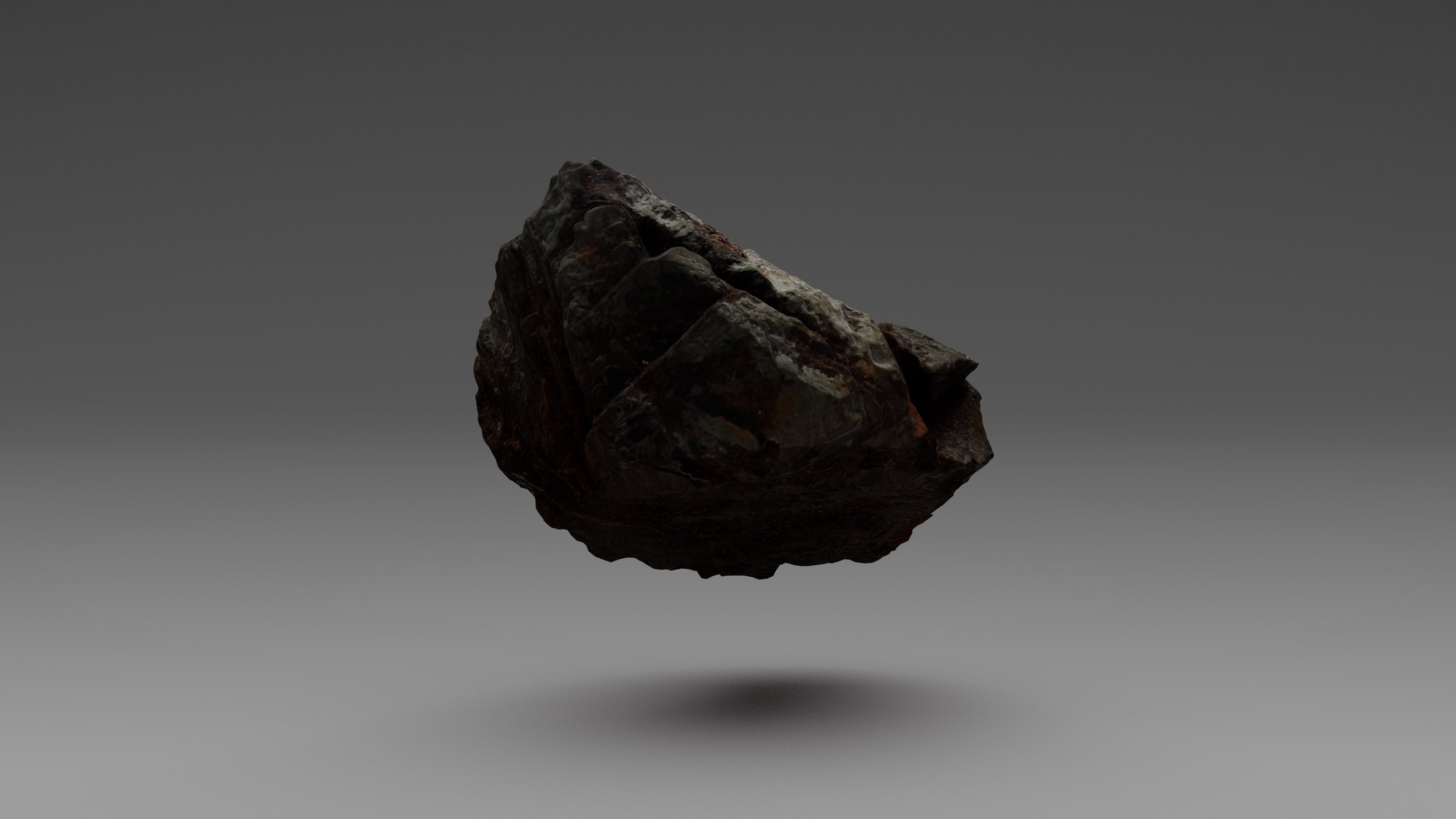Charles Stankievech. The Desert Turned to Glass (Muonionalusta Meteorite Study), 2012/2022. LiDAR Model.
Meteor-logos
Exhibition Essay by: Dehlia Hannah & Nadim Samman
In the brutalist raw concrete atrium of the former Centennial Planetarium, a meteorite hovers just above an expanse of black sand. As the titular work at the center of Charles Stankievech’s solo exhibition, this sculptural ensemble indefinitely suspends the moment that The Desert Turned to Glass. Its surface smoothed by a fiery descent through the atmosphere, such a large lump of iron would create a great cloud of dust and melt the sand upon impact, marking the surface with a crater. Pregnant with possibility, the thin layer of air between the meteorite and the ground contains pasts and futures; seeds of life and intimations of extinction; sacred and naturalistic speculations. This condensed airspace also implies a brief history of meteorology. The discipline’s originary questions are articulated in Aristotle’s foundational text Meteorologica (350 B.C.E.); ‘What lies between the earth and the heavens? Of what elements is this domain composed? And how far above sea level does it extend?’
Prior to the intensive study of gasses during the scientific revolution of the 17th century, no firm distinction was drawn between what we would now call the atmosphere and the cosmos. The discipline of meteorology holds within itself an ancient idea of continuity between earthly and celestial weather, its scope comprising all phenomena that “take place in the region nearest to the motion of the stars,” including clouds, comets, meteors, winds, thunder, lightning, and other forms of celestial fire such as auroras, and earthquakes. If the latter seem a stretch out of bounds, consider that celestial phenomena were commonly thought to augur earthly events, from the association of tides with the moon to the concurrence of less common events, such as an eclipse with an earthquake, or a shooting star with a strange birth or an instance of cultural upheaval. As a discipline that seeks to make sense of “events that are natural, though their order is less perfect than that of the [stars],” meteorology contends with the unstable epistemological territory of natural irregularity. It is the persistence of the meteor in meteorology that makes the weather forecast the butt of so many jokes. Yet it is also the spectacular and unpredictable arrival of meteorites, paradigmatic objects of wonder, that opens up the domain of the sacred. Indeed, the sculptural cast on display here references the Papamihaw Asiniy or ‘flying rock’ sacred to the Plains Cree. Recent efforts to repatriate the original meteorite after a series of colonial expropriations navigate the stone’s capacity to shed and accrue meaning, and to hover above determinate significance.
Screening within the planetarium’s dome, The Eye of Silence suggests a hallucinatory blurring of cosmic and the chthonic. Evoking critical moments in the Earth’s evolution, the work explores a series of antinomies: passages between creation and destruction, expansion and contraction, intrusion and extrusion, within and without, microcosm and macrocosm. The newly commissioned video marshals high atmospheric footage of the Albertan Badlands, the Utah Salt Flats, Icelandic and Japanese volcanoes, and a meteorite crater and cave paintings located within a region of the Namibian desert long closed off to visitors because of diamond mining. A field of stars becomes a point map of a lidar scan of a cave. At every polarity, the suggestion of a mystical inversion obtains, wherein a horizon or vanishing point unfolds to offer new vistas. An abyss, such as outer space, or some geological fissure, delivers a new world. Combining static camera, drone footage, and a mirrored screen, a churning mass of clouds, lava, and stone provides receptive viewers with ample grounds to project their own associations. Is that a face in the mist? In such moments, another antinomy is revealed—between subject and object; evidence and speculation. The Eye of Silence both depicts and implies metamorphosis on every level.
Mediating between stellar and subterranean motifs, fog, mist, clouds and smoke venting from a fresh lava flow spill across the screen. At times it softens tough terrain, while elsewhere stimulating a trance-like pareidolia, or roiling within volcanic craters. The visual dynamism of air recapitulates not only the ‘invention of the concept of atmosphere in the history of meteorology, but also the formation of the earth’s atmosphere back in deep geologic time—in a word, to creation itself. Eye of Silence calls forth otherworldly experience from within the depths and heights of this world, at the same time cultivating an aesthetic disposition to receive them.
…to be continued in a mirrored pair of essays by Dehlia Hannah & Nadim Samman, Editors of the forthcoming book Charles Stankievech: The Desert Turned to Glass, Hatje Cantz, Oct 2023.


